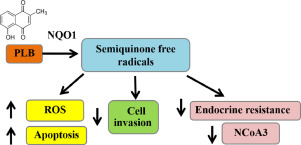Phytomedicine ( IF 6.7 ) Pub Date : 2019-11-11 , DOI: 10.1016/j.phymed.2019.153133 Nalinee Pradubyat 1 , Nithidol Sakunrangsit 1 , Apiwat Mutirangura 2 , Wannarasmi Ketchart 1

|
Background
PLB is a natural naphthoquinone compound isolated from the roots of Plumbago indica plant. Our previous study reported the inhibitory effect of Plumbagin (PLB) on human endocrine resistant breast cancer cell growth and cell invasion.
Hypothesis/Purpose
Since PLB is a naphthoquinone compound, it can be reduced by the cytosolic NADPH: quinone oxidoreductase 1 (NQO1) enzyme. NQO1 expression is upregulated in various types of aggressive cancer including breast cancer. This study investigated the impact of NQO1 on anti-cancer effects of PLB in endocrine-resistant breast cancer cells.
Study Design
This study was an in vitro study using ER-positive cell line (MCF7) and endocrine-resistant cell lines (MCF7/LCC2 and MCF7/LCC9 cells).
Methods
The roles of NQO1 in anti-cancer activity of PLB were investigated by using NQO1 knockdown cells, NQO1 inhibitor and NQO1 overexpressed cells. To study the impact of NQO1 on the effects of PLB on cell viability, apoptosis, invasion and generation of ROS, the following assays were used: MTT assays, annexin V-PE/7-ADD staining flow cytometry, matrigel invasion assays and DCFHDA assays. To study the mechanism of how NQO1 mediated PLB effects in tamoxifen response and apoptosis, we assessed the levels of mRNA expression by using qRT-PCR.
Results
1. In this study, NQO1 was upregulated in endocrine-resistant cells.
2. PLB did not change the expression of NQO1 but it was able to increase NQO1 activity.
3. The inhibitory effects of PLB on cell proliferation, cell invasion and expression of tamoxifen resistant gene were attenuated in NQO1 knockdown cells or in the presence of NQO1 inhibitor.
4. The effects of PLB to induce apoptosis and generate ROS were also decreased when NQO1 activity was inhibited or when the NQO1 expression was reduced.
5. The anti-cancer effects of PLB increased when NQO1 was upregulated.
Conclusion
The effects of PLB in endocrine-resistant breast cancer cells is dependent on NQO1’s activity.
中文翻译:

NADPH:醌氧化还原酶 1 (NQO1) 介导的白铅素对内分泌耐药 MCF7 乳腺癌细胞的抗癌作用
背景
PLB 是一种从 Plumbago indica 植物根中分离出来的天然萘醌化合物。我们之前的研究报道了红花素 (PLB) 对人内分泌抗性乳腺癌细胞生长和细胞侵袭的抑制作用。
假设/目的
由于 PLB 是一种萘醌化合物,它可以被细胞溶质 NADPH:醌氧化还原酶 1 (NQO1) 酶还原。NQO1 表达在包括乳腺癌在内的各种侵袭性癌症中上调。本研究调查了 NQO1 对 PLB 在内分泌耐药乳腺癌细胞中的抗癌作用的影响。
学习规划
本研究是使用 ER 阳性细胞系 (MCF7) 和内分泌抗性细胞系(MCF7/LCC2 和 MCF7/LCC9 细胞)进行的体外研究。
方法
通过使用 NQO1 敲低细胞、NQO1 抑制剂和 NQO1 过表达细胞研究 NQO1 在 PLB 抗癌活性中的作用。为了研究 NQO1 对 PLB 对细胞活力、凋亡、侵袭和 ROS 产生的影响的影响,使用了以下测定:MTT 测定、膜联蛋白 V-PE/7-ADD 染色流式细胞术、基质胶侵袭测定和 DCFHDA 测定. 为了研究 NQO1 如何在他莫昔芬反应和细胞凋亡中介导 PLB 作用的机制,我们使用 qRT-PCR 评估了 mRNA 表达水平。
结果
1. 在本研究中,NQO1 在内分泌抗性细胞中上调。
2. PLB不改变NQO1的表达,但能够增加NQO1的活性。
3.PLB对细胞增殖、细胞侵袭和他莫昔芬抗性基因表达的抑制作用在NQO1敲低细胞或NQO1抑制剂存在下减弱。
4.当抑制NQO1活性或降低NQO1表达时,PLB诱导细胞凋亡和产生ROS的作用也降低。
5.当NQO1上调时,PLB的抗癌作用增强。
结论
PLB 在耐内分泌乳腺癌细胞中的作用取决于 NQO1 的活性。











































 京公网安备 11010802027423号
京公网安备 11010802027423号